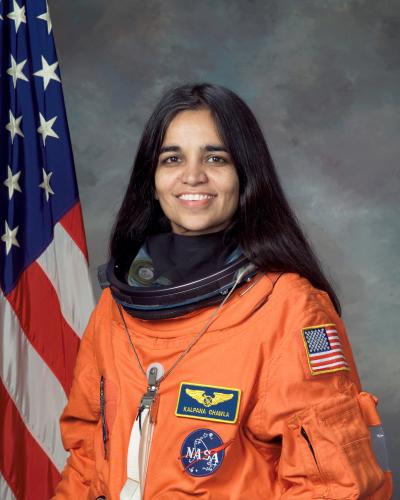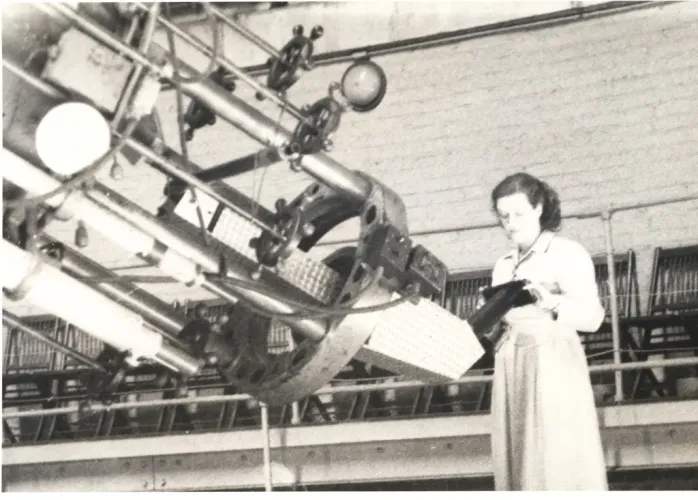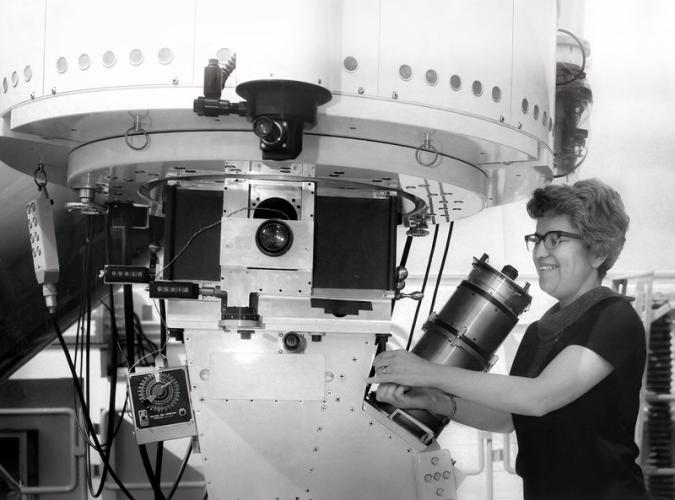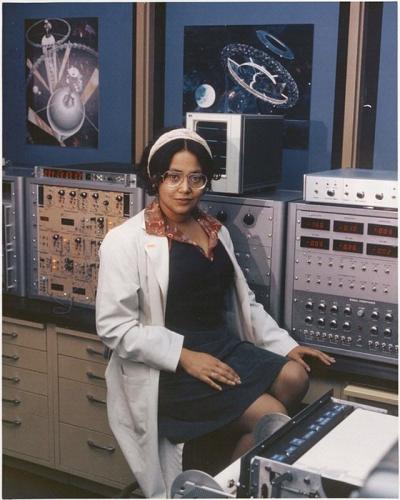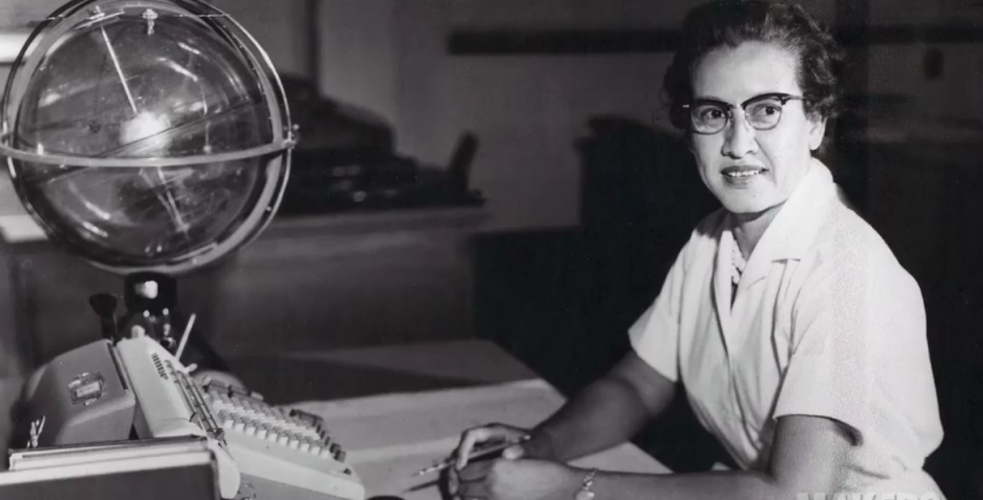
Katherine Johnson at NASA. Photo courtesy of Wikimedia Commons.
Katherine Johnson, Mathematician Who Helped America Get to the Moon
Katherine Johnson started working at NASA’s precursor, the National Advisory Committee for Aeronautics (NACA), in 1953 in the segregated West Area Computing section. As NACA became NASA in 1958, Johnson joined the program to do trajectory analysis for America’s first human spaceflight on mission Freedom 7.
In 1962, Johnson was called upon to work on the trajectory computations for the orbital Friendship 7 mission. Trajectory calculations had been programmed into the IBM computers, but astronauts were hesitant to put their lives in the care of machines that were prone to blackouts and technical difficulties. As part of a preflight checklist, astronaut John Glenn reportedly asked engineers to “get the girl” (Johnson) to run the numbers by hand. “If she says they’re good, then I’m ready to go,” Johnson remembers him saying. The mission was a success, and Johnson went on to help calculate the trajectory for the 1969 Apollo 11 flight to the Moon. She retired from NASA in 1986 and was awarded the Presidential Medal of Freedom by President Obama in 2015. She died in 2020 at the age of 101.
Kalpana Chawla, Engineer and Astronaut
Born in India to Pakistani parents, Kalpana Chawla began working at the NASA Ames Research Center in 1988, specializing in computational fluid dynamics and vertical takeoff and landing. After becoming a naturalized citizen in 1991, Chawla applied for the NASA Astronaut Corps and was selected in 1994 as a candidate. She completed her first flight in 1997 on STS-87 on the space shuttle Columbia.
Chawla’s second flight, STS-107, launched in 2003. Again aboard Columbia, Chawla and the other six crew members spent 16 days in space and conducted over 80 space experiments. The crew rotated schedules to continue research for 24 hours a day in areas including anti-cancer therapies, cardiovascular and musculoskeletal changes due to space flight, water recycling devices, and testing of various communications devices. Tragically, while enroute to land at Kennedy Space Center on Feb 1, 2003, the Columbia broke apart while re-entering Earth’s atmosphere and all seven members of the crew died. Chawla was 40 when she died, and she had logged over 720 hours in space. Amazingly, numerous research components aboard the shuttle were found in the debris, and the accident itself has been extensively studied to improve the safety of future missions. Chawla was posthumously awarded the Congressional Space Medal of Honor in recognition of her career and sacrifice.
Dr. Nancy Grace Roman, the “Mother of Hubble”
Dr. Nancy Grace Roman joined NASA in 1959, only six months after the agency’s formation. By 1960, she was the Chief of Astronomy and Relativity and became NASA’s first female executive. With interest in a large telescope above the atmosphere growing, Roman worked to unite the efforts of the broader scientific community. “All I did was bring together a collection of astronomers from all over the country and some NASA engineers, and get them to sit down together and come up with something that the engineers thought would work, and that the astronomers thought would do their job. That was really the beginning of the serious efforts on the Hubble,” Roman said in an interview. She then began her decades-long fight to convince first NASA and then Congress that the idea of building an unmanned, 9-foot telescope was worth pursuing.
Throughout the 1960s and 1970s, Roman worked to secure funding for the program by courting donors and writing testimony for Congress to justify the project’s $500 million budget. Roman retired from NASA in 1979, but the work she did set the Hubble Space Telescope on the path to a successful launch in 1990 and earned her the name “Mother of Hubble.” Roman died in 2018 at the age of 93.
Dr. Vera Cooper Rubin, Astronomer Who Proved Existence of Dark Matter
Dr. Vera Rubin’s groundbreaking work began in her doctoral program at George Washington University. Her dissertation, published in 1954, argued that galaxies clumped together rather than distributing randomly through the universe. Rubin joined the Carnegie Institution of Washington’s Department of Terrestrial Magnetism in 1965. While there, she focused her research on galaxy rotational curves by using some of the world’s most powerful telescopes.
As Rubin observed more and more galaxies, she found more and more evidence that the galaxies were spinning. In 1970, she and her research partner Kent Ford published a paper on the Andromeda Galaxy’s rotational curve and concluded that there had to be an enormous amount of invisible mass in the galaxy that was behaving gravitationally. Due to the matter’s lack of interaction with light, it is called dark matter. Rubin continued her studies and observations in other galaxies, continuing to find the same phenomenon. The proven existence of dark matter has shaped our understanding of planets, stars, and galaxies. Due to Rubin’s invaluable contribution to our understanding of space, she will be honored on a quarter in 2025 as part of the American Women Quarters Program.
Dr. Patricia Cowings, Scientist that Studied Space Sickness
Dr. Patricia Cowings joined NASA in 1971 and became the first American woman to receive astronaut training. Though she never went to space, Cowings designed a program to help astronauts combat space sickness. Space sickness, caused by psycho-physiological and biological responses, was an increasing problem astronauts faced in their space travel. As a research psychologist in the Biomedical Division of NASA’s Ames Research Center, Cowings developed a patented training program that teaches astronauts to control as many as 26 physiological functions related to motion sickness. Cowings designed a training program consisting of 12 half-hour sessions where astronauts are taught to mentally evoke a sensation, like the relaxation of certain muscles, to bring about a desired physiological change. This biofeedback approach, known as the autogenic-feedback training exercise (AFTE), teaches subjects to regulate things like their heart rate, rate of respiration, and the flow of blood to the hands. At the age of 75, she is still actively employed by NASA and currently researches spatial disorientation that occurs during launch and re-entry.
Cowings designed a training program consisting of 12 half-hour sessions where astronauts are taught to mentally evoke a sensation, like the relaxation of certain muscles, to bring about a desired physiological change. This biofeedback approach, known as the autogenic-feedback training exercise (AFTE), teaches subjects to regulate things like their heart rate, rate of respiration, and the flow of blood to the hands. At the age of 75, she is still actively employed by NASA and currently researches spatial disorientation that occurs during launch and re-entry.
Related Posts
Meredith Herndon is a writer and editor for the Smithsonian American Women’s History Museum.
